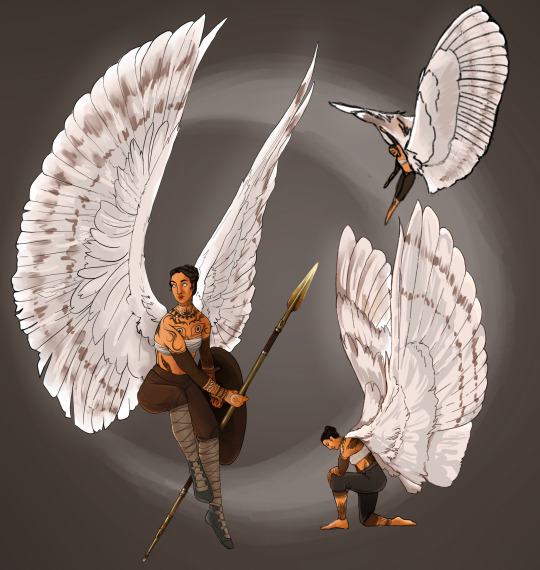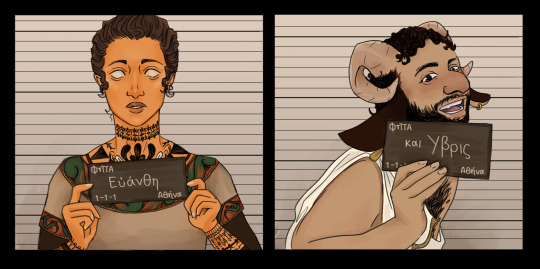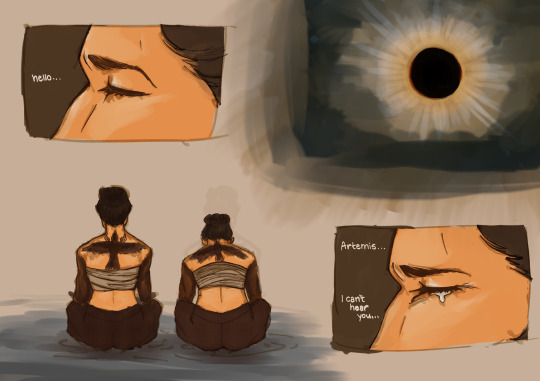#euanthe my beloved
Text
~~~~~EUANTHE DUMP!!!!~~~~~

Here is some more Euanthe stuff I made a little bit ago. She has been on my mind as of late and all I wanna do is draw her morreeeee. However, *sigh* I have finals I have to do, so for now this must suffice. Most of her tattoos are Magic Tattoos from TCoE, but recently she got a new fun homebrew tattoo I found online called the Tattoo of the Peregrine which basically lets her sprout big ole wings. She is a druid, so she can wildshape, but her wings help in situations when I don’t really want to use up a wild shape just to use her crazy perception to scout out an area. This particular tattoo was given to her by Athena at a level up (I forgot which level but we are lvl 17 now, and it was pretty recent, so it may have been 17 idk) so I figured it’d be fun to use owl wings for the reference, plus I feel like of all of the owls, barn owls are the most Artemis coded, seeing as she is the champion of Artemis.

Omg her first full body piece I made!! This one for sure is a throwback. I was still exploring her character and trying to fit as much of it into her design as possible. I’ve got a soft spot for this piece even through she has changed a bit since then. I still imagine her armor like this, maybe a bit more leather here and there and some more fancy stuff since they’ve leveled up quite a bit since this piece was made but similar vibes. I don’t usually draw her in full armor just because I like drawing her tattoos so much, but here she is. Oh and how could I forget about Argos!! He is her oldest friend and the best boy in all the ancient greek world. She carved him out of marble she found in her woods one day a very long time ago. Before the campaign started, he would sit on a plinth at one side of the the forest Euanthe was tasked with caring for and greet travelers when they arrived at its borders. These particular woods can be quite disorienting, and many a traveller have gotten swallowed up entirely by its charms, so Euanthe and Argos existed there as guides as much as they were protectors.

This one dates itself… The character on the right is Hybris, champion of Dionysus, so this format was quite fitting lmao. This was following some events in campaign in which Hybris may or may not have accidentally made a child go blind and become a seer and almost get arrested and by proxy almost made the rest of the party get arrested… but its ok because he fixed it by starting a rager that got the entire city of Athens to get drunk and completely forget about it all… ah the memories…

Ah yes, the Albion arc…
Basically, we were in a place that was guarded by a special kind of magic which meant that we couldn’t contact our gods and they couldn’t see us (hence the lunar eclipse). Euanthe in particular, since she is basically just a living amphora, doesn’t sleep, so she spends most nights meditating in temples of Artemis with the other huntresses. This arc was particularly hard for her. Her relationship with Artemis is complicated. She knows that Artemis created her for a reason, but she doesn’t know what that reason is, and she worries that her love for Artemis has grown outside of the bounds it was meant to.
I do really like this piece, but it’s very unpolished and I would like to revisit it soon to finish it up and maybe add a few things.

Then there is this onneeee… soo basically, I love this character so much that I may or may not have brought her into a Curse of Strahd campaign. But it’s ok i swear because she’s different in CoS I swear. Several hundred years have passed since the events of her original campaign, and she has grown quite jaded since the fall of the Greek Pantheon. In the original campaign, she’s pretty bubbly and optimistic, so its a pretty fun character development to play with.
Anyway… I love her and miss her and just wanted to post these as I reminisce…
#my art#dnd character#dnd art#artists on tumblr#euanthe theadris#euanthe my beloved#we need to play greek campaign soon#or else I will explode#greek campaign#gotta love greek mythology insert characters#artemis#me? obsessed with the moon? pffffft noooo…#curse of strahd
14 notes
·
View notes
Note
Wait... are you saying that Simcoe was possibly a Bicon, in addition to being a hero of Upper Canada?
That, my friend, I am! Albeit with the usual caveats that there are some things we cannot say for certain.
I think there are hints pointing towards Simcoe having been possibly romantically, or even sexually, inclined towards men as well as women.
Apologies for my tardy reply, but this got a tad long, so please proceed under the cut:
Edward Drewe: "My Dorilas"
The first hint is the poem I was talking about, written by his fellow officer Edward Drewe, whom Simcoe knew since childhood. Drewe wrote the poem as a farewell to Simcoe upon being invalided back home to England early in the Revolutionary War.
For me, the repeated emphasis on the sorrow of parting in elborately dramatic scenes (such as imagining what would happen if Simcoe would die before also returning home, complete with a description of his "mangled corse" [sic, and a bit sick, too]) and particularly the repeated address of Simcoe as "Dorilas" seem to point in that direction.
The lovely and ever helpful @my-deer-friend was able to pinpoint a potential origin for the appellation "Dorilas" from the Tale The Loves of Dorilas and Euanthe, published in the Oxford Magazine in 1774.
Assuming the name is a direct reference to either this particular story or similar stories, due to the personal nature of the poem, my assumption would be that Drewe, complementing Simcoe's Dorilas, cast himself in the role of Euanthe.
This, by the way, is the last paragraph of the story:

"[G]olden shafts" and Venus having "crowned the night when Dorilas the pride of swains enjoyed his beloved Euanthe" does sound quite... Well, they surely weren't just looking at is stamp collection together.
If the appellation "Dorilas" in Drewe's poem indeed does refer to Dorilas and Euanthe, I think that would be a very distinct hint as to how the relationship between Drewe and Simcoe might have looked like.
John André: "an officer whose superior integrity and uncommon ability did honour to his country, and to human nature."
Another man who was very important to Simcoe was John André. They knew each other, and enjoyed spending time together. They were of a similar age and had shared interests. Similarly to André, Simcoe could draw well and was a man not shy of conviviality.
When André was captured, Simcoe approached Clinton submitting a plan for André's rescue which would have included putting his own life on the line that was however refused by Clinton.
Now, I'm perfectly sure I have seen Simcoe's letter to Clinton somewhere, but cannot find it. It seems to exist, too, because the plan to rescue André was also known to Simcoe's biographer, Mary Beacock-Fryer, who makes mention of it, sadly without referencing the original (Beacock-Fryer, Mary: John Graves Simcoe. A Biography, p. 56.).
What I can provide you with however is the assertion, in Simcoe's own words, that he
[...] had given directions that the regiment should immediately be provided with black and white feathers as mourning, for the late Major Andre, an officer whose superior integrity and uncommon abiity did honour to his country, and to human nature.
John Graves Simcoe, Journal, p. 152 (1844 reprint).
In his so-called Journal, a work he compiled in order to highlight his own role in the war and political stances which he wrote with the intention to serve as a stepping-stone for his (political) career after his return to civilian life (and half-pay) in England, there are not many hints as to how his relationship with André may have looked like, which, given its nature, makes sense.
He does however highlight, in his Journal and later private letters, how greatly André's death upset him, and allegedly, though I have never found any proof for this, André's self-portrait, drawn at the eve of his execution, was copied by Simcoe's artiscally gifted wife to give to Honora Sneyd, André's former sweetheart.
There are no concrete hints to any relationship in a romantic or sexual sense with André, in any case however, I think it bespeaks their close bond that Simcoe was willing to sacrifice his own life for André, and had the Queen's Rangers add feathers to their hats as a token of respect and rememberance to him.
Mary Anne Burges: Defying Social Expectations
Simcoe was by most accounts a person who was naturally jovial, affectionate and inclined to see the good in everyone; local stories and historical anecdotes about Simcoe highlight his approachable character.
One curious personal relationship was that with Mary Anne Burges, his wife's best friend; the two were a 'package deal', which he knew; legend has it that after she had accepted his proposal, Elizabeth Gwillim, the future Mrs. Simcoe, sent her fiancé to talk to her best friend and promise her that he would never come between them.
How much of this story is true will remain lost to history, but Simcoe had no issues with Burges moving into the vincinity and being a constant visitor. She even became, in the absence of blood-relations, an aunt of sorts to the Simcoe children who would help take care of the four eldest daughters while their parents were away in Upper Canada.
Mary Anne Burges and Elizabeth Simcoe were friends ever since their teenage years and Burges sometimes came to stay with her bestie, who was then living with her maternal aunt Margaret and the latter's husband, Admiral Samuel Graves, whenever her cash-strapped parents considered putting pressure on her to get married already.
Mary Anne Burges remained single for life, carved out a professional existence (albeit an at times precarious one) for herself writing for magazines, had a great interest in the natural sciences and even became a single (foster) mother to an orphaned relation. Here is what she wrote to Elizabeth when a gentleman decided to try his luck with her by way of a surprise proposal:
[...] so I wrote him word that I had more a determination to continue single all my life [...].
Mary Anne Burges to Elizabeth Simcoe, 8 June 1795.
Her refusal to the proposal had nothing to do with the particular gentleman in question; she was simply not interested in men in a romantic or sexual capacity, which she seems to have been very open about. In another letter to her best friend, shortly after the Simcoe's had left for Upper Canada in 1792, she gives an account of a spat between herself and the notoriously quarrelsome Margaret Graves, jealous of the close relationship between her niece and Mary Anne Burges. Margaret Graves mused loudly that friendships between married (Elizabeth Simcoe) and unmarried ladies (Mary Anne Burges) were very improper, because unmarried ladies might ask a married lady about advice regarding her lovers. Mary Anne Burges coldly replied that "[t]hat can easily be overcome by not having any lovers."
Mary Anne Burges remained a trusted friend close with the Simcoe-family for as long as she lived. Given that the Simcoes were very close, and Mary Anne had been around the Graves' house, too, I would guess that Simcoe would have known either from Mary Anne Burges herself or from his wife, that she was resolved not to conform to the common expectations held for women in the day. Despite that, she was allowed a close relationship not only with his wife, but particularly with his children.
To me, Simcoe's relationship with Mary Anne Burges evidences that he was more, for lack of a better word, open-minded than one would expect of an aspiring social climber with politically otherwise conservative leanings in the late 18th century, which may have influenced his view on and willingness to engage in romantic or perhaps even sexual relationships with other men.
Samuel Graves: Simcoe's upbringing
This open-mindedness likely stems from his upbringing between his mother's and his godfather's household. While I sadly know only very little about his mother, I know quite a fair bit about his godfather Samuel Graves.
Graves valued education (and scolded his older brother because he considered his nephews too little educated to successfully make their way in the world), was married to a member of the Bluestocking circle who believed that women should have more legal rights, especially regarding social mobility through education and vocational training as well as allowing married women to hold property in their own name, and allowed Mary Anne Burges to stay in his home whenver she required an escape from her home life.
Even more interesting is that due to a severe case of malaria contracted while serving abroad as a young man, he had grown infertile. He knew this, and was open about it to his family. Taking this into account, his marriages defy the contemporary socio-religious expectations somewhat as they could never produce any offspring; his two marriages were, from the pieces of evidence I have, likely for love.
His second wife, Elizabeth Simcoe's aunt Margaret, née Spinckes, appears to have been firm on never wanting any children of her own due to having watched her sister die in childbirth, which, coupled with her aversion to giving up her substantial fortune to a husband, had kept her from marrying so far; looking at her marriage to Samuel Graves, it seems that she not only trusted him with her property, she was also happy to have sexual relations with him, some light allusions to this apparently very delctable part of married life she left behind in letters.
Conclusion:
It was in this at the second glance rather surprising environment that Simcoe grew up in, and that may have influenced his personal development, and perhaps instilled in him an acceptance of people not conforming to social expectations, which may have influenced his possible relationships with men such as Edward Drewe and perhaps even John André.
Simcoe's acceptance of Mary Anne Burges as a close friend to his wife and daughters (and to himself, too), who by modern terminology would likely fall under the umbrella term "queer", shows that throughout his life, he was accepting of people who, especially regarding personal and potentially sexual relationships, defied social expectations.
How his own relationships with other men may have looked like concretely, and how the people involved would have perceived, termed and described them might sadly be forever lost to history; for a great analysis of terminology and (what we today consider to be) queerness in an 18th century context, I will link this excellent post by @my-deer-friend.
Especially Edward Drewe's potentially sexually underpinned poem may suggest that a relationship going beyond a romantic friendship between him and Simcoe may have existed.
I think that in Simcoe's case, no prior evaluation of his friendships with men of a similar age prior to his marriage has taken place yet because firstly, most scholarship on him was written in the 19th/early 20th century when queer history was, to put it mildly, not exactly a priority, and secondly, because his very happy, monogamous marriage (about which he wrote poetry containing such great lines as "[...] shall my Eliza with true passion burn") and eleven (!) children do not instantly suggest any attraction to other men on his part.
A further, more in-depth analasys would be a desideratum on my part, especially because I believe there is some basis for it meriting further research.
#ask#ask reply#john graves simcoe#elizabeth simcoe#samuel graves#margaret graves#mary anne burges#queer history#history#18th century
34 notes
·
View notes